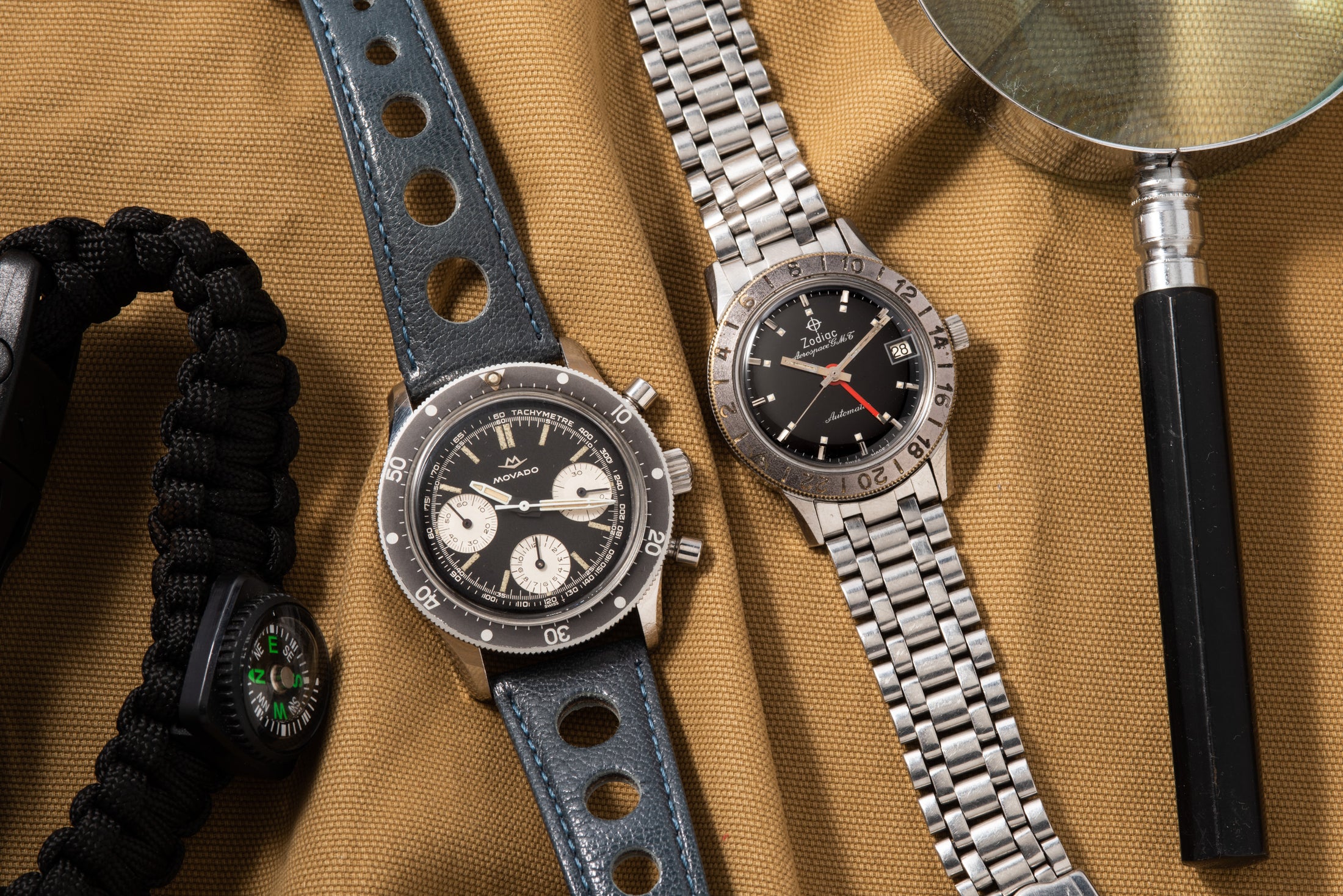Two of the most utilitarian watch complications are used to time events and to track a second time zone. But what truly offers more utility in a smartphone-filled world?
Watch lovers and collectors are obsessed with the notion of utility — which is funny, as the modern wristwatch’s overall utility is questionable, to say the least. In a world in which everyone and their mother has a device in their pocket with more computing power than that which launched the Apollo 11 mission, one could justifiably ask: What the hell does a person need a wristwatch for? Especially a mechanical one?
We’re not even gonna go there.
Chances are if you’re reading the content on this website, you’re already well down the rabbit hole and on your way to Wristwatch Wonderland — or you’ve been there for some time, smoking a hookah with that giant caterpillar thing and discussing the finer points of hairspring manufacturing. (Or something along those lines.)
Point is: You’re a watch guy or gal already, so we understand one another. We all know we don’t need watches anymore; we just like them. We like them for what they signal about us (we’re people who value time, and value being on time), we like them for their design, for their craftsmanship, for their micro-engineering, etc, et al, and on and on.
But back to the notion of utility. There was indeed a time — a time long before the personal computer — in which having a chronograph or a GMT-equipped watch offered significant, daily-usable utility.
After all, this is why these complications were developed in the first place: because they were needed. At some point during the Great War, it was supremely useful to know how far away the enemy's ghastly (and deadly) artillery was. And at some point during the 1950s, it was supremely useful for a jet pilot to be able to track both local and UTC time. These functions weren’t gimmicks — you think Rolex spent all that R&D money developing a gimmick? That’s some 21st-century (not 20th-century) thinking!
What about today, however — the iPhone-carrying present. Folks still need to time things, and folks still need to keep track of people and events across different time zones. But if all this stuff is available on our smartphones and our computers, what’s more useful on one’s wrist in the 2020s? A chronograph or a GMT?
The Chronograph

Universal Genève Compax ref. 222101/1 circa 1960s IN THE SHOP
The chronograph — Greek for, vaguely, “time writer” — has been around for well over two centuries. (If you wanna get technical, it’s been around for thousands of years, but we’re talking wristwatches and pocket watches, here.) The modern version is an invention of one Louis Moinet, a French horologist, in 1816.
A chronograph allows you to record time, i.e. to time a passing event. How? Fairly simply: There’s a scale (generally in the form of a subdial on your watch) that displays seconds, minutes or hours. When you push a button (a “pusher”) on your watch, the small hand in this subdial begins moving. When you press another pusher to stop the chronograph, the hand will display, along its scale, the number of seconds, minutes or hours that have elapsed. Pretty brilliant, and pretty useful! (Hey, if it was good enough to save the crew of Apollo 13, it’s good enough for Joe Schmo from New Jersey — or wherever — to time a parking meter with.)

What’s it used for today? This is the tricker question to answer. Personally, the writer doesn’t own a chronograph at the moment, but uses the timing bezel on his dive watch to time: cooking, particular segments of his practice routine on guitar (one can’t just play Free Bird for three hours straight each evening — or, one shouldn’t), how long clothes have been in the dryer, etc. In short: all sorts of stuff. Of course, all this can be timed on one’s phone, but it’s just as easy — if not easier — to time it on one’s wrist. And in a world in which we spend hours every day looking at screens, the break given by using one’s watch is a genuine pleasure.
So just how useful is a modern chronograph, whether mechanical or quartz? The author would rate it at a nine, frankly, and that’s only because “10” is a perfect score, and it’s tough to award a perfect score to anything other than Sean Connery’s performance in The Last Crusade.
The GMT

Ok, so what about the dual-time watch? (For the sake of simplicity, we’re using as our model the Rolex GMT-Master, released in 1954 and developed at the request of PanAm pilots so that they could track both local and UTC time, the universal standard time of the skies.)
Originally, a fourth hand was slaved to the main hour hand and really only functioned as a day/night indicator on its own, which meant that the watch in question required a rotating bezel inscribed with a 24-hour scale to offset this hand’s reading. This way, one could quickly ascertain the time in a zone, say, three hours away. These days, these hands — or, as on the Rolex GMT-Master II, the local hour hand — are independently adjustable, making it much easier to quickly set the second (or local) time zone. Certain watches even feature both a rotating 24-hour bezel and a 24-hour scale on the dial, making it possible to keep track of three distinct zones.
These things are supremely useful — if you have need of monitoring the time somewhere other than where you’re currently located. In today’s globalized economy, many, many people do have this need, whether it’s keeping track of a loved one or friend overseas, or a business partner in another part of the country, or the time back home when traveling. The only question is whether this complication offers more utility than that of the chronograph.
We’d rate the utility of the GMT complication at an 8 — meaning, it’s supremely useful, but perhaps not quite as useful as the chronograph, for the simple reason that not everyone needs to keep track of a second time zone, but almost everyone needs to time something.
The Verdict

To be fair, many people — most? — wear a GMT-Master II today simply for the cool, bi-color look of the bezel, and because the watch is an iconic status symbol these days. (I know one guy who doesn’t even know how to set the fourth hand on his GMT-Master II.) But with respect to utility, more folks are probably gonna benefit from the time-recording functionality of a chronograph more than the dual-time display of a GMT-equipped watch.
So what does this mean, practically? Well, if you only have the budget for one of the two types, we’d say start with a chronograph. (Unless of course you know that you’ll actually use a GMT — then by all means, get one!) After that, if you’re still in the watch buying game, move on to a two-timer. Of course, there are no hard and fast rules, here — we’re just trying to help out with the decision-making process. At A:S, we carry plenty of both types of watches, and we’re happy to meet you in our offices to try ‘em all on for size.
Some of Our Favorite Chronographs
Omega Speedmaster

The Speedy has been a fan favorite since its debut in 1957, but it was the 1969 Moon landings that truly gave this model the marketing kick it deserved. We’ve got all sorts of Speedies in all different price ranges. Make an appointment to swing by the showroom and see ‘em all!
Price Range: ~$4,500+
Rolex Cosmograph Daytona

When this most desirable of tool watches debuted in 1963, it didn’t actually say “Daytona” on the dial — that came a year or two later. Now, this automatic chrono is consistently difficult to come by, and for good reason: It’s a superbly built piece of kit that’ll last a lifetime.
Price Range: ~$25,000+
IWC Portugieser Chronograph

Looking for a slightly dressier chrono? Look no further than the stunning Portugieser from IWC, part of a series that has its origins in a custom order for a time-only watch back in the 1930s. These days, the Portugieser Chronograph features in-house movements and plenty of style.
Price Range: ~$3,650+
Some of Our Favorite GMT Watches
Rolex GMT-Master

The first commercially available and popular GMT-equipped watch, the original GMT-Master was released in 1954, having been commissioned by Pan American Airways for its flight crews. These days, it’s arguably even more useful, and comes in myriad interesting colorways.
Price Range: ~$14,000+
Zodiac Aerospace GMT

Back in the 1960s and ‘70s, Zodiac made several dual-time and world timer watches in slim cases with automatic movements and matching bracelets. Much more affordable than their counterparts from Rolex and other brands, they’re just as cool today, and perfectly sized.
Price Range: ~$3,000+
Heuer Autavia GMT ref. 1163/11630

A true “watch guy’s” watch, the Autavia GMT combines Heuer’s signature chronograph with a GMT complication and the brand’s automatic movement. Housed in a funky ‘barrel’ case and kitted out with a ‘Pepsi’ bezel, these are some of the coolest tool watches ever made, full stop.
Price Range: $10,350+













